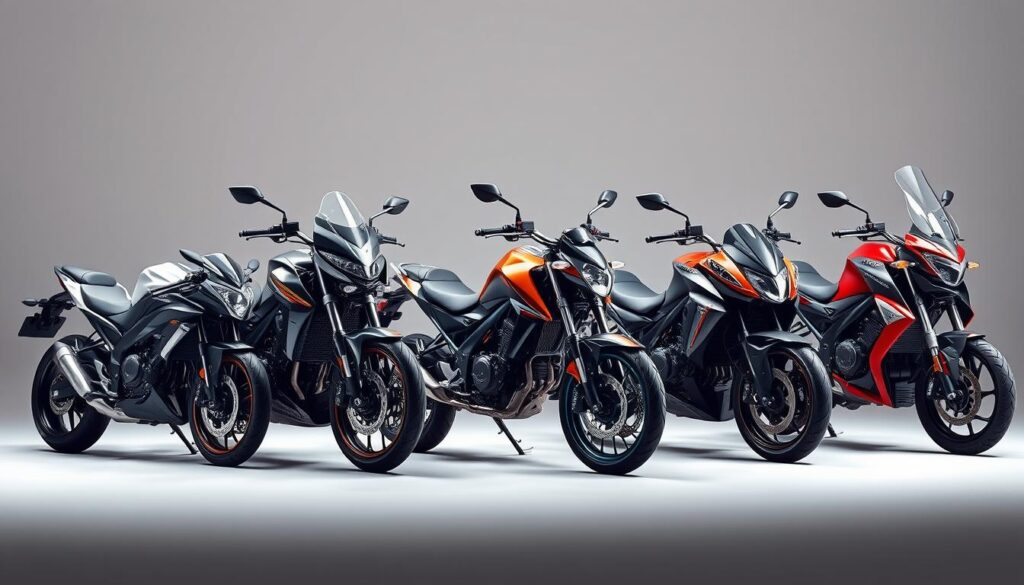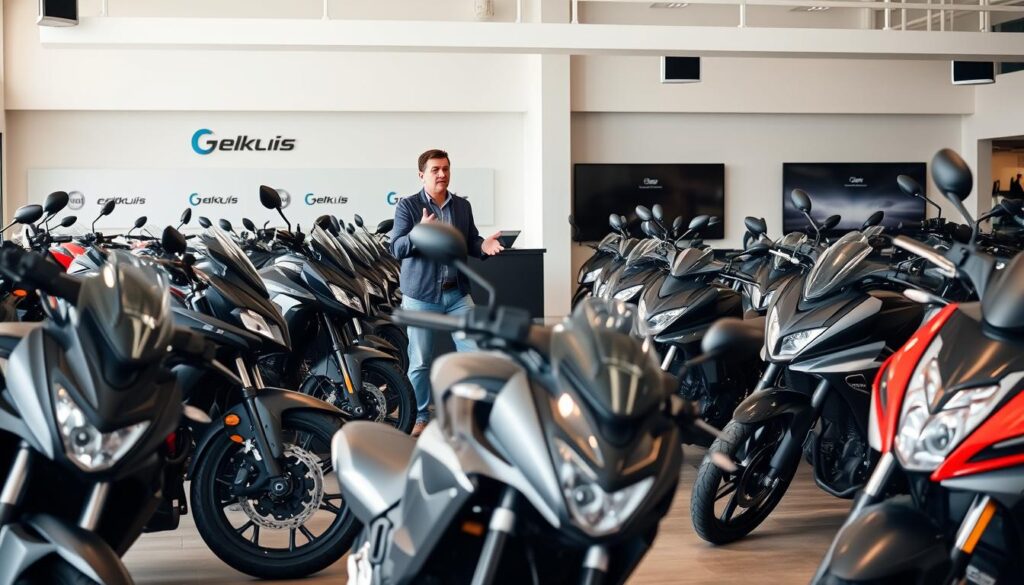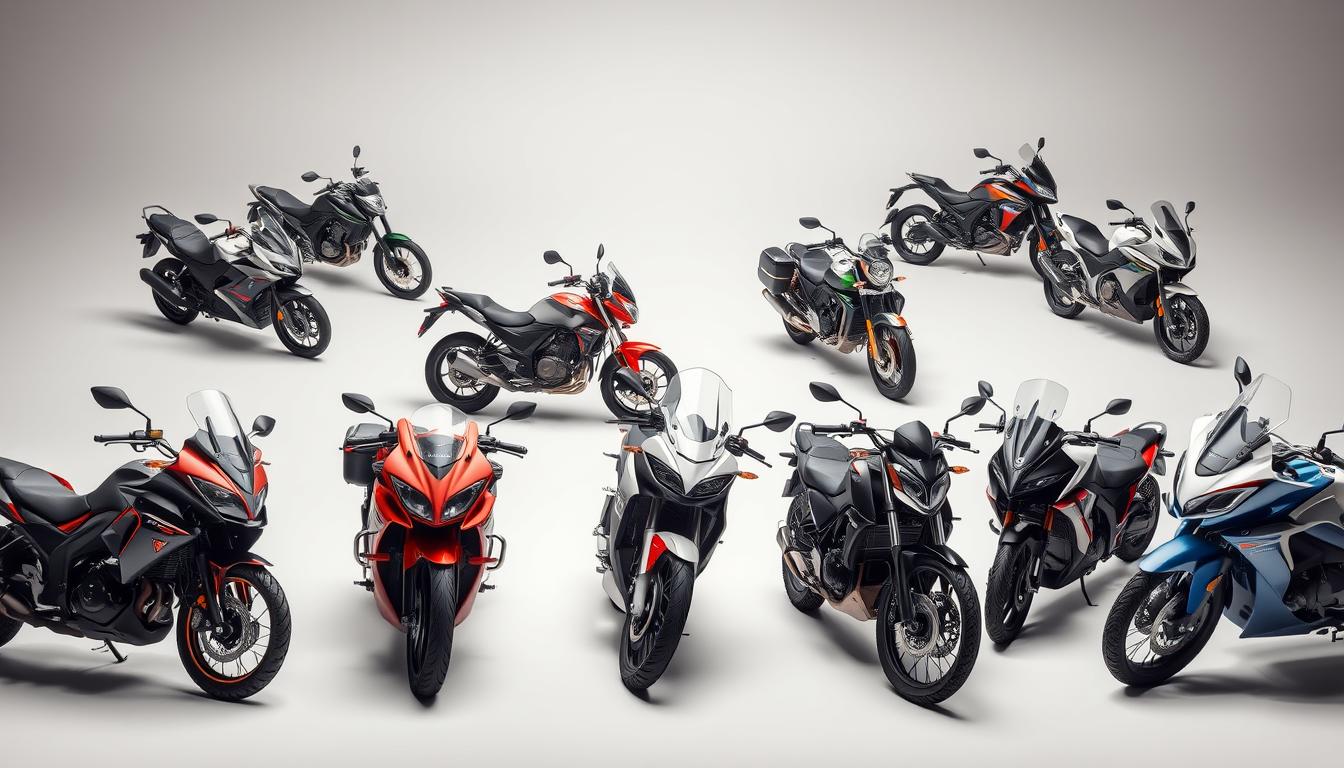Motorcycles are more than just a way to get from point A to point B. They offer a sense of adventure and a way to express your style. Whether you’re new to riding or have years of experience, knowing about the different types of motorcycles can enhance your journey.
Choosing the right motorcycle is about finding a partner for your two-wheeled adventures. There are bikes for city rides and others for long trips. Each type of motorcycle has its own strengths, whether you’re looking for speed, comfort, or thrill.
Start by understanding which motorcycle fits your skill level and needs. Beginners might prefer bikes with smaller engines, while more experienced riders can look at high-performance bikes. The goal is to find a bike that matches your abilities.
Key Takeaways on Different Motorcycle Types
- Motorcycle selection depends on individual riding experience and style
- Engine size plays a crucial role in bike performance and manageability
- Different motorcycles serve unique purposes, from commuting to touring
- Personal comfort and skill level are essential in choosing the right bike
- Motorcycle types range from sport bikes to cruisers, each with distinct characteristics
Understanding Different Motorcycles and Their Purpose
Exploring different motorbikes means learning about motorcycle types. This world is full of design, performance, and special functions. It’s fascinating to see how each type is made for a specific purpose.

Motorcycle design is an art that affects how you ride. Each style is made for a certain way of riding, depending on where you ride and what you like.
Key Factors in Motorcycle Classification and Styles
Manufacturers sort motorcycles by a few key things:
- Engine size and setup
- Frame design
- What you plan to use it for
- How it performs
Impact of Motorcycle Design on Performance and Ride Quality
Design greatly affects how a motorcycle performs. Small changes can make a big difference in how it handles and rides.
| Motorcycle Type | Engine Size | Primary Use | Key Characteristics |
|---|---|---|---|
| Standard | 125-1,000cc | General riding | Versatile, great for beginners |
| Sport | 300-1,000cc | High-performance riding | Light, fast |
| Cruiser | 250-2,000cc | Relaxed street riding | Low seat, lots of power |
Matching Different Motorcycles to Various Riding Environments
Your riding spot is key in choosing a motorcycle. City riders might like light scooters. Off-road fans might choose bikes made for both road and dirt.
“Choosing the right motorcycle is about matching your riding style with the perfect machine.” – Motorcycle Enthusiast Magazine
Knowing these details helps riders pick the right bike. It makes sure the bike fits their lifestyle and riding dreams.
Getting Started: Essential Considerations for New Motorcycle Riders

Choosing your first motorcycle is exciting but also challenging. Different motorcycles offer unique experiences for new riders. It’s important to pick the right type that fits your skill level and riding goals.
When looking at motorcycles for beginners, consider these key factors:
- Engine Size: Novices should look at 250cc to 500cc engines
- Weight: Lighter motorcycles (300-400 pounds) are easier to handle
- Price: Budget-friendly options usually cost between $4,000 and $10,000
“Start small, ride smart” – Motorcycle Safety Foundation
Here are some beginner-friendly motorcycle recommendations:
- Honda CB300R (286cc)
- Suzuki GSX250R (248cc)
- Kawasaki Versys-X 300 (296cc)
Safety is the most important thing. Take a motorcycle safety course to build confidence and learn essential skills. These courses use training bikes between 150cc to 250cc, offering a safe place to learn.
Pro tip: Invest in quality protective gear and maintain your motorcycle regularly for a safe and enjoyable ride.
Different Motorcycle Styles: A Comprehensive Guide
Choosing the right motorcycle can change your riding experience. Knowing the different types helps you pick the perfect bike for your lifestyle and riding style.
Sport and Performance Motorcycles: Features and Benefits
Sport bikes are the fastest and most precise in design. They are made for those who love speed and advanced tech. They are known for their quick acceleration and handling.
- Kawasaki Ninja ZX-10R: Known for high-revving engines
- Ducati Monster 1200 S: Recognized for exceptional speed and agility
- Honda CBR600RRG: Lightweight and ideal for urban commuting
Cruisers and Touring Motorcycles: Comfort and Long-Distance Capability
Cruiser motorcycles offer a unique ride focused on comfort and classic looks. They are made for long rides and have relaxed seating.
| Model | Key Features | Best For |
|---|---|---|
| Harley-Davidson Road King | Large saddle, significant torque | Long-haul rides |
| BMW S1000 RR | Adjustable suspension, heated grips | Luxury touring |
Adventure and Dual-Sport Motorcycles: Versatility for On and Off-Road
Adventure motorcycles are great for those who love both paved roads and off-road adventures. They are tough and perform well.
“Adventure bikes are the Swiss Army knives of motorcycles” – Motorcycle Enthusiast Magazine
- KTM 1290 Super Duke R: Rugged off-road capabilities
- Honda Africa Twin: Legendary reliability
- BMW R 1250 GS: Powerful boxer engine with advanced electronics
Each motorcycle type has its own benefits. Your ideal bike depends on your riding style, experience, and personal taste.
Comfort and Ergonomics in Various Motorcycle Types
Ergonomics are key when picking a motorbike. The right design can make your ride comfy and fun. This is true for all types of motorcycles.
- Seat height and design
- Handlebar positioning
- Footpeg placement
- Overall rider posture
“A well-designed motorcycle feels like an extension of your body, not a machine you’re battling.”
Studies show good ergonomics make a big difference. Riders who tweak their bike’s ergonomics say it’s better. They feel more comfortable and in control.
| Ergonomic Adjustment | Improvement Percentage |
|---|---|
| Handlebar customization | 30% reduced fatigue |
| Footpeg repositioning | 25% increased comfort |
| Seat height optimization | 40% decreased anxiety |
For the best ergonomics, keep your knees at 20-30 degrees. Make sure you can put both feet on the ground when stopped. This reduces strain and boosts control.
Choosing a sport bike, cruiser, or touring model? Know how your body fits the bike. Each type has its own ergonomics. These can greatly affect your comfort and safety.
Performance Characteristics Across Different Motorcycle Categories
Understanding the performance of different motorcycles helps you choose the right one. Each type of sport bike has its own features that affect your ride. These include engine type and how the bike handles.
Motorcycle performance changes a lot depending on the type and setup. Your riding style and skill level will help pick the best bike for you.
Engine Configurations and Power Delivery Across Motorcycle Types
Engine setup is key when looking at motorcycles. Sport bikes usually have:
- Inline-four engines for fast speeds
- V-twin engines for strong torque
- Single-cylinder engines for easy handling
Handling and Maneuverability in Different Motorcycle Categories
Sport bikes handle differently than other types. They corner sharply, while cruisers are stable and smooth.
| Motorcycle Type | Handling Characteristics | Ideal Riding Environment |
|---|---|---|
| Sport Bikes | Aggressive, Responsive | Racetracks, Winding Roads |
| Cruisers | Stable, Relaxed | Highway, Urban Streets |
| Adventure Bikes | Versatile, Adaptable | Mixed Terrain |
Braking Systems and Safety Features in Various Motorcycles
Safety is important when choosing a motorcycle. Modern bikes have advanced braking systems:
- Anti-lock Braking Systems (ABS)
- Traction control
- Electronic stability controls
“Knowing your motorcycle’s performance characteristics can mean the difference between a thrilling ride and a dangerous situation.” – Motorcycle Safety Expert
Performance is important, but so is rider skill and awareness for safety.
Urban vs. Long-Distance Riding: Choosing the Best Motorcycle
Choosing the right motorcycle depends on where you ride most. Some bikes are perfect for city streets, while others are great for long highway trips.
Urban riders need bikes that are easy to handle and save fuel. These bikes usually have:
- Lightweight design
- Smaller engine capacity
- Enhanced fuel efficiency
- Agile handling in traffic
The Nightster® is a great example of a versatile motorcycle. It’s perfect for city rides and occasional highway trips. Its small size makes it easy to navigate through crowded streets.
“Choose a motorcycle that matches your most frequent riding environment” – Motorcycle Experts
Long-distance riders need different bikes. Touring motorcycles have:
- Comfortable ergonomic design
- Advanced suspension systems
- Substantial storage capacity
- Wind protection features
These bikes also have tech like cruise control and anti-lock braking. This makes long trips safer and more comfortable.
Your ideal motorcycle should fit your riding style. Whether you’re in the city or on the highway, it should feel right.
Maintenance and Reliability Considerations for Various Motorcycles
When looking at different motorcycles, knowing about maintenance is key. Your bike’s reliability affects how well it performs, stays safe, and feels to ride.
Regular care can prevent many problems and make your bike last longer. Riders who take care of their bikes early on can save a lot on repairs.
Service and Maintenance Requirements by Motorcycle Type
Every motorcycle type needs its own maintenance plan. Here are some important points:
- Sport bikes need more frequent check-ups
- Cruisers usually require less work
- Adventure bikes need thorough inspections often
Cost of Ownership Comparison for Different Motorcycles
| Motorcycle Type | Average Annual Maintenance Cost | Service Frequency |
|---|---|---|
| Sport Bikes | $500-$800 | Every 3-4 months |
| Cruisers | $300-$600 | Every 6 months |
| Adventure Bikes | $600-$1000 | Every 4-5 months |
Longevity and Durability Factors in Various Motorcycle Models
Motorcycles vary in how reliable they are. Doing thorough safety checks can spot up to 25% of problems before they get worse. Brands like Honda and Suzuki are known for making durable bikes.
“Preventive maintenance is the key to a motorcycle’s long and healthy life.”
Understanding maintenance needs helps you choose a bike that’s right for you. It’s about finding a balance between performance, reliability, and cost over time.
Budget and Value: Making a Smart Motorcycle Purchase
Choosing the right motorcycle is more than just about speed. It’s about finding a balance between your dreams and your budget. When you compare different motorbikes, knowing the financial side is key to making a wise choice.
Motorcycle prices can range from $4,599 for entry-level bikes to $35,000 for top models. It’s important to look beyond the price. Think about the whole experience of owning a motorcycle.
“A smart motorcycle purchase considers not just the sticker price, but the total cost of ownership.”
Budget Breakdown for Motorcycle Ownership and Value Considerations
- Initial Purchase: $5,000 – $10,000 for beginners
- Safety Gear: Approximately $1,300
- Annual Maintenance: Around $1,000
- Insurance: $141 – $364 per year
| Motorcycle Model | Base MSRP | Engine Size |
|---|---|---|
| Honda Rebel 300 | $4,849 | 286cc |
| KTM 250 Duke | $4,599 | 250cc |
| Triumph Speed 400 | $4,995 | 400cc |
| BMW F 750 GS | $9,995 | 853cc |
When comparing motorcycles, here are some tips to get more value:
- Look for end-of-season deals
- Consider slightly older models
- Factor in long-term maintenance costs
- Check warranty and roadside assistance options
Pro tip: Don’t forget to budget for essential accessories like a quality helmet and protective gear. These investments can save you from potential costly medical expenses in the long run.
Conclusion
Choosing the right motorcycle is a thrilling journey. It’s not just about picking a bike. The wide range of motorcycles out there has something for everyone. Whether you love the power of cruisers or the speed of sport bikes, there’s a bike for you.
Your riding style and what you like matter a lot. There are bikes for all, from adventure bikes to electric ones. Think about the engine size, where you’ll ride, and how you feel on the bike to choose wisely.
The world of motorcycles is always changing. New tech like electric bikes and safety features are coming out. You might want a classic Harley or a modern Honda CBR. Take your time, test ride, and listen to your gut to find your perfect bike.
Getting a motorcycle is more than buying a bike. It’s about living a life of freedom and adventure. Start by exploring the world of motorcycles and finding the one that speaks to you.
FAQ
What are the main types of motorcycles available?
There are several types of motorcycles. Sport bikes are for speed, cruisers for comfort, and touring bikes for long trips. Adventure motorcycles are great for off-road, and dual-sport bikes do both. Standard/naked bikes are versatile and easy to handle.
How do I choose the right motorcycle as a beginner?
Beginners should look for motorcycles with smaller engines (250-500cc). They should also have lower seats and be lighter. Standard bikes and smaller cruisers are good for new riders because they’re easier to control.
What factors should I consider when selecting a motorcycle?
Think about your experience, what you’ll use it for, and your physical abilities. Your budget, comfort, and performance needs are also important. Don’t forget about safety features and how the bike feels to ride.
Are sport bikes suitable for everyday riding?
Sport bikes are fast but not always comfortable for daily rides. They’re best for experienced riders who love speed. For daily use, standard bikes or commuter motorcycles are more practical.
How important is motorcycle maintenance?
Keeping your motorcycle in good shape is key for safety and performance. Different bikes need different care. Always check the oil, tires, and follow the recommended service schedule.
What’s the difference between touring and adventure motorcycles?
Touring bikes are made for long trips on paved roads. They have big fairings, lots of storage, and comfy seats. Adventure bikes can go on and off-road. They have strong suspension, high ground clearance, and a tough design.
How much should I budget for my first motorcycle?
Your budget should cover the bike’s cost, insurance, gear, maintenance, and any upgrades. Entry-level bikes cost between ,000 and ,000. Add
FAQ
What are the main types of motorcycles available?
There are several types of motorcycles. Sport bikes are for speed, cruisers for comfort, and touring bikes for long trips. Adventure motorcycles are great for off-road, and dual-sport bikes do both. Standard/naked bikes are versatile and easy to handle.
How do I choose the right motorcycle as a beginner?
Beginners should look for motorcycles with smaller engines (250-500cc). They should also have lower seats and be lighter. Standard bikes and smaller cruisers are good for new riders because they’re easier to control.
What factors should I consider when selecting a motorcycle?
Think about your experience, what you’ll use it for, and your physical abilities. Your budget, comfort, and performance needs are also important. Don’t forget about safety features and how the bike feels to ride.
Are sport bikes suitable for everyday riding?
Sport bikes are fast but not always comfortable for daily rides. They’re best for experienced riders who love speed. For daily use, standard bikes or commuter motorcycles are more practical.
How important is motorcycle maintenance?
Keeping your motorcycle in good shape is key for safety and performance. Different bikes need different care. Always check the oil, tires, and follow the recommended service schedule.
What’s the difference between touring and adventure motorcycles?
Touring bikes are made for long trips on paved roads. They have big fairings, lots of storage, and comfy seats. Adventure bikes can go on and off-road. They have strong suspension, high ground clearance, and a tough design.
How much should I budget for my first motorcycle?
Your budget should cover the bike’s cost, insurance, gear, maintenance, and any upgrades. Entry-level bikes cost between $4,000 and $8,000. Add $1,000 to $2,000 a year for insurance, upkeep, and accessories.
Are there motorcycles suitable for urban commuting?
Yes, scooters, small standard bikes, and lightweight naked bikes are perfect for cities. They’re fuel-efficient, easy to handle, and cheaper to insure. Plus, they’re easy to park in tight spots.
What safety features should I look for in a motorcycle?
Look for ABS, traction control, adjustable suspension, and good visibility. Also, invest in quality protective gear. Taking a motorcycle safety course is a good idea.
How do I determine the right motorcycle size for my body?
Check the seat height, weight, and how easy it is to reach the handlebars. Your feet should touch the ground when seated. Test ride different bikes to find the best fit for you.
,000 to ,000 a year for insurance, upkeep, and accessories.
Are there motorcycles suitable for urban commuting?
Yes, scooters, small standard bikes, and lightweight naked bikes are perfect for cities. They’re fuel-efficient, easy to handle, and cheaper to insure. Plus, they’re easy to park in tight spots.
What safety features should I look for in a motorcycle?
Look for ABS, traction control, adjustable suspension, and good visibility. Also, invest in quality protective gear. Taking a motorcycle safety course is a good idea.
How do I determine the right motorcycle size for my body?
Check the seat height, weight, and how easy it is to reach the handlebars. Your feet should touch the ground when seated. Test ride different bikes to find the best fit for you.


1 thought on “Exploring Different Motorcycles: What’s Best for Your Riding Style?”